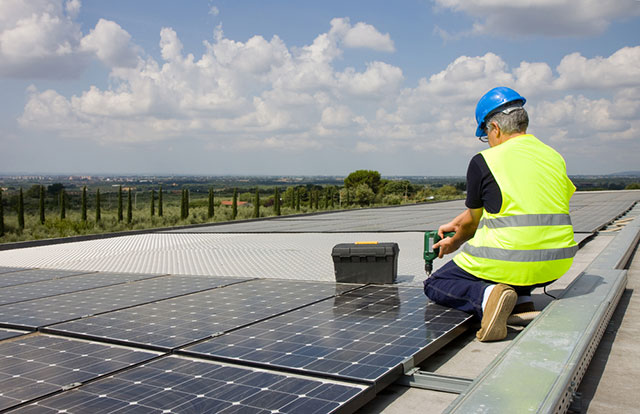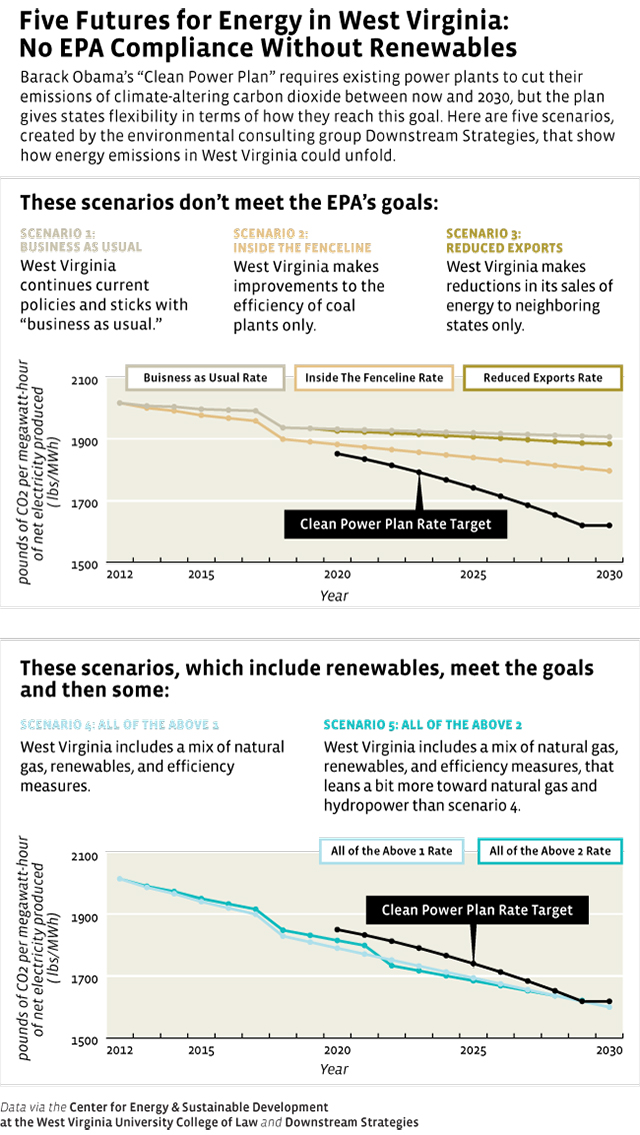
West Virginia’s attorney general, Patrick Morrissey, and attorneys general from 23 other states filed a lawsuit against the Obama administration. At issue was the Clean Power Plan, which aims to cut carbon emissions from the power sector by 32 percent by 2030, in an effort to hold off climate change.
The Environmental Protection Agency, responsible for enforcing the new rules, has suggested three strategies that states can combine as they see fit to achieve the cuts: make coal-fired power plants more efficient; meet new energy needs with natural gas; and develop renewable sources like wind and solar.
Morrissey, whose state generates more than 94 percent of its electricity from coal, has been threatening for months to sue over the plan. He says that it is an overreach of federal power and would lead to the loss of thousands of mining jobs as well as an increase in energy prices.
However, Gov. Earl Ray Tomblin announced that the state will submit a compliance plan, in case the lawsuit is unsuccessful. He didn’t mention which strategies the state would employ to comply with lower emissions standards.
Though Cecil Roberts, the head of the United Mine Workers of America, one of the labor unions involved in the suit against the Obama administration, said he supports the governor’s decision and offered some ideas.
He also suggested that growing energy needs in the state should be served by plants that fire both coal and natural gas.
Not everyone in West Virginia sees the future of energy this way. Among the state’s residents, support for solar and energy efficiency has been growing. And policy experts say that they’re helping to build the foundation of compliance with Obama’s plan, while environmental activists say they’re moving the state closer to a transition away from fossil fuel dependence.
Take Ginger Danz, who lives in the small town of Fayetteville, not far from the state capital of Charleston. Danz and her family had solar panels installed on their roof this summer.
She links their decision directly to replacing coal and other fossil fuels as energy sources.
“West Virginia has been a super sacrifice zone for the extractive industry,” she said. “My husband and I decided that whatever we could do to lessen our dependence on fossil fuels, we should.”
Though she said it was a stretch financially, she and 35 more in Fayette County were able to get a deal on their panels. Last year, they participated in a solar purchasing cooperative that cut the cost of installing solar panels by about 20 percent. This type of co-op allows individuals to buy solar panels and installation services as a group to get a lower price.
Similar cooperatives are cropping up in Charleston, Wheeling, and Morgantown with support from WV Sun, the same nonprofit that helped to start the cooperatives in Fayette.
And the stakes aren’t limited to climate change; local health is also an issue. Mountaintop removal has been consistently linked to health problems in nearby towns, as well as serious environmental problems.
“We’re sacrificing our health and our lives so that people in other states can save a few cents on their electricity bills,” says Vernon Haltom, executive director of the anti-mountaintop removal mining group, Coal River Mountain Watch.
It’s Up to the Grassroots
A handful of neighbors with solar panels may not seem like much next to the state’s powerful coal industry and its allies in the state government. But, for a number of reasons, the neighbors may have time on their side.
Devi Glick, a senior associate at the energy-focused think tank Rocky Mountain Institute, says that enforcing the Clean Power Plan will mean less coal in West Virginia’s future.
Glick believes that utilities will be moving away from coal and seeking other energy sources to replace it. “Solar is going to be one of the lower-cost options.”
Yet West Virginia has been slower to adopt policies that support investment in solar than many of its neighbors. The state has just 3 megawatts of installed solar capacity, while Ohio and Maryland have many times that, at 104 megawatts and 272 megawatts, respectively.
State-implemented regulations called “renewable energy portfolio standards” are part of the reason behind that difference. These regulations, which are on the books in Ohio and Maryland, require energy companies to source a certain percentage of their energy from renewables, such as solar or wind power.
The policy is usually designed to encourage investment in renewables and help offset the cost of solar panels for homeowners. But, the standards in West Virginia, called the “Alternative and Renewable Energy Portfolio Standards,” were not effective in supporting investment in renewable energy.
That’s in part because they defined certain types of coal and natural gas as “alternative.” Given this, energy companies could meet the standards without investing in renewables at all.
So environmental activists in the state didn’t put up much of a fight when the legislature repealed the standards in January of this year. Evan Hansen, a principal with Downstream Strategies, an environmental consulting and research firm based in Morgantown, says it was a largely symbolic move by the legislature, to show where they stand on renewable energy.
When Republican legislators attempted to weaken the state’s net metering rules, solar industry supporters and homeowners with solar panels rallied to ensure that the bill preserved net metering rules in the state. Net metering allows customers who produce their own electricity, through solar panels for example, to sell energy back to the grid at a competitive rate. This helps them save money on their monthly electricity.
“We had 150 to 200 phone calls and signatures [opposing the legislation] in less than a day,” said Mike McKechnie, president of Mountain View Solar, the state’s largest solar installation company. “A small community of solar owners changed the tide of net metering.”
The future of net metering in West Virginia is still in flux though, as Gov. Tomblin signed a bill in March that solar advocates say could open the door for larger fees and electricity rate hikes for homeowners with solar panels. The law also creates a commission to look more closely at the costs and benefits of net metering.
Danz says she’s aware of the possibility of more fees and it worries her. “We refinanced our house in order to [get solar panels],” she said. “But it’s worth it to us.”
In the absence of those or other incentives for renewables, Glick says the push will need to come from elsewhere.
“I think it puts a strong burden on advocacy organizations to really make the case that solar power and efficiency are the cheapest way to comply with the Clean Power Plan,” Glick said.
Hansen and fellow researchers at the Center for Energy & Sustainable Development at the West Virginia University College of Law are taking steps to do just that. They published a study exploring five scenarios for the future of energy in the state.
Three of those scenarios show the state failing to comply with the Clean Power Plan: by sticking to business as usual, by making improvements in energy efficiency without adding renewables, and by scaling back sales of energy to neighboring states. The two remaining scenarios, which meet the Clean Power Plan goals, involve substantial increases in renewable energy.
Both of these plans still show about 75 percent of the state’s energy coming from coal. But the amount sourced from renewables would double to as much as 8 percent.
Haltom, an activist fighting mountaintop removal mining in the state, would like to see even more renewables.
“We don’t expect [coal] to go away completely, but we do need to make a valiant effort to get off it,” he said. “The argument that wind and solar won’t provide enough energy is a self-fulfilling prophecy.”
For the time being, even the more modest goals laid out in Hansen’s proposal will require a political struggle. But the solar already installed is helping to build that momentum.
“Not only is there real electricity being generated with solar,” Hansen said, referring to solar purchasing cooperatives and other groups that have built capacity. “But it also changes the political dynamics because all of the sudden there’s way more people who have a stake in solar and policies that support it. Changing the politics is one of the more important things over the long run.”
Because the potential for solar power in the state is underutilized, the report emphasizes it as a major area for growth. Hydropower, where most of the four percent of West Virginia’s total existing renewable energy production comes from, has less potential to expand. That’s why, although total renewable capacity would need to merely double, solar capacity would need to grow 200 times larger by the year 2030 to reach the 410 megawatts Hansen’s report says would be needed in either of its two scenarios that meet the president’s goals.

Where Will the Jobs Be?
Ben Newhouse, the city manager of Hurricane (pronounced hur-i-cunn) just north of Charleston, agrees that it’s important for people to see alternatives energy in action.
Drivers can see Hurricane’s 84-panel solar array just off Interstate 64 in front of the water treatment plant. The city government secured a $193,000 federal block grant to pay for the panels in 2013.
“The reason why we chose this spot was that the panels would be seen right off the interstate,” said Ben Newhouse, the city manager. “So people would say, ‘Wait, if the city can do this, maybe I should think about doing this as well.'”
The grant was part of the Department of Energy’s Energy Efficiency and Conservation Block Grant program, which provided $9.5 million to West Virginia for the implementation of projects that support green jobs.
In addition to energy efficiency, the money funded three more solar projects in the state: a 25-kilowatt array of solar panels on the courthouse in Morgan County; a 19-kilowatt array on the municipal building in the town of Man; and a 4-kilowatt array on the village municipal building in Beech Bottom.
Newhouse sees these solar projects as a driver for community development. “The legislature needs to change their mindset about the investment [in solar],” he says. “It’s about how communities can take small steps to benefit themselves.”
Hansen echoes this support for alternative energy as an investment in jobs and economic growth.
In a state where the scarcity of jobs is always a concern, that raises some eyebrows.
For Hansen, it boils down to costs and benefits. The costs include scaling back the mining, selling, and burning of coal, but the benefits are likely to look like huge investments in renewable energy.
“Those benefits can be in West Virginia or they can be everywhere else,” he says. “The way to get those benefits is to try to direct as much investment into renewable and efficiency as you can within the state lines.”
West Virginia’s Department of Environmental Protection is accepting public comment on a feasibility study for the state’s compliance plan through December 31.
Join us in defending the truth before it’s too late
The future of independent journalism is uncertain, and the consequences of losing it are too grave to ignore. To ensure Truthout remains safe, strong, and free, we need to raise $43,000 in the next 6 days. Every dollar raised goes directly toward the costs of producing news you can trust.
Please give what you can — because by supporting us with a tax-deductible donation, you’re not just preserving a source of news, you’re helping to safeguard what’s left of our democracy.